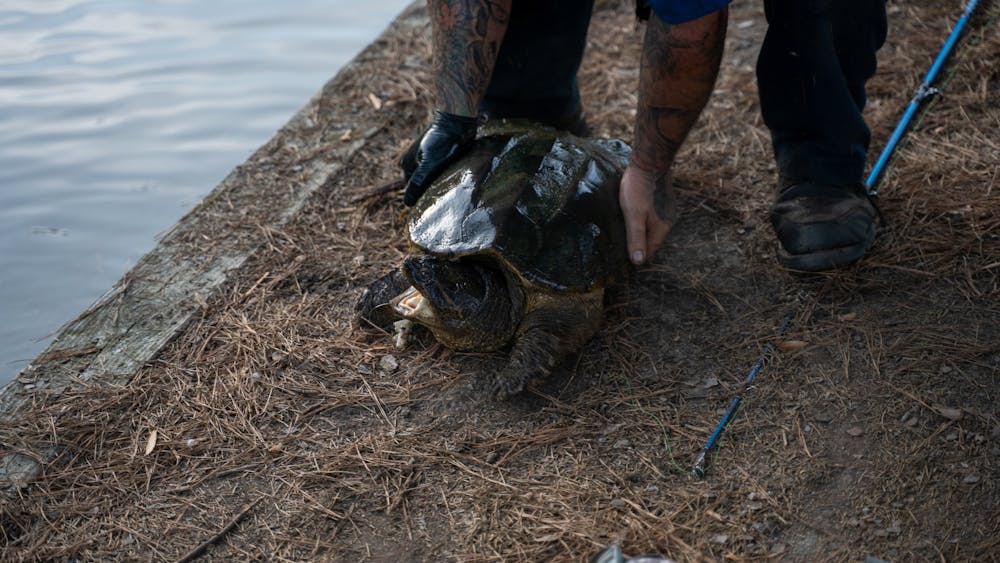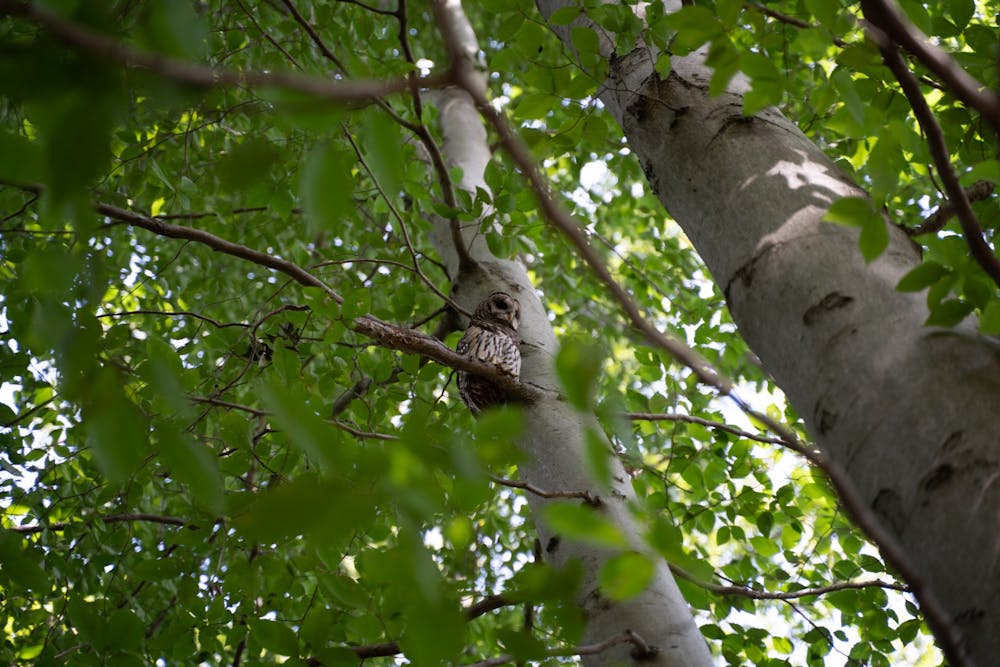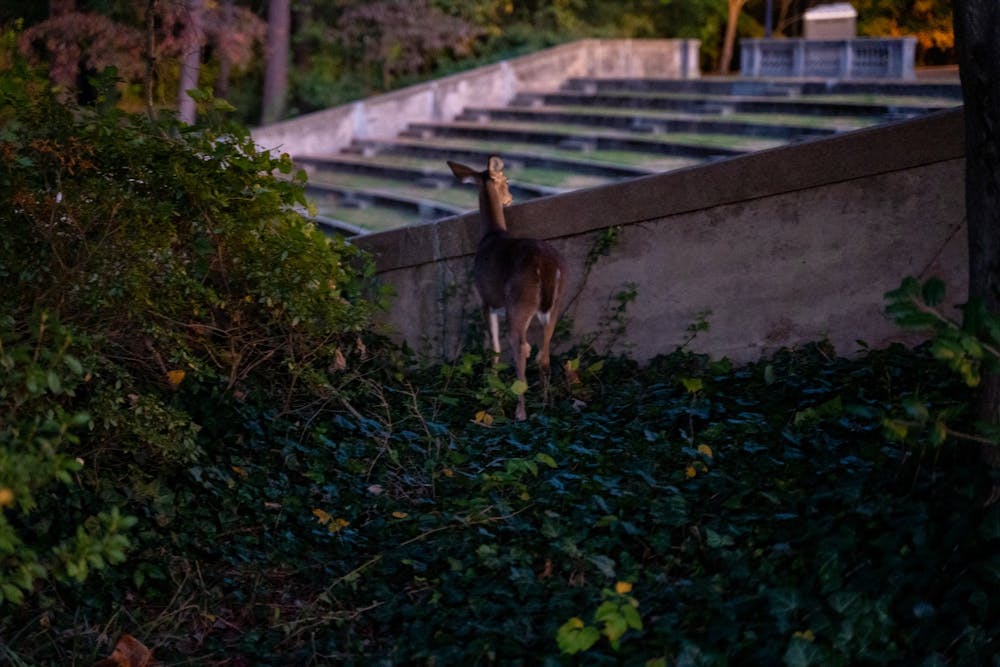If your only experience with animals on campus is the geese in the lake or the squirrels in the trees, then “you are missing 90% of what is cool.”
That’s the view of ecology professor Peter Smallwood, who wants to encourage students to take a closer look at the wildlife at the University of Richmond.
Swimming, slithering, soaring and scampering, the wildlife on campus is far from just the geese and squirrels. From the lake to the forest and the sky, animals make up a large population of life on campus.
Beneath the surface of Westhampton Lake dwell American eels, carp, bass, bluegill and sunfish, Smallwood said.
Also lurking underwater is UR’s large array of turtles. The harmless ones are painted turtles, red-eared sliders and musk turtles. The dangerous ones are the common snapping turtles, including a 40-pounder that Smallwood calls “Quasimodo.”

A common snapping turtle is wrestled out of the lake after becoming caught on fishing hook lined with raw chicken on Sept. 20, 2019. The hook was removed at the scene by the hands of the fisherman who caught the reptile.
The lake was once a temporary home to an otter, Smallwood said.
“It hung out in the lake for a bit and realized that it's not going to get a date here and went back,” Smallwood said, “but that means it swam up the creek, got to Tyler Haynes and instead of turning back, it walked through the parking lot or the driveway and then jumped into the lake.”
The lake welcomes a variety of ducks including domestic, wood, dabbling and diving. There are also cormorants, a great blue heron and the Canada geese.
Campus icon Triceragoose, which Smallwood believes to be a hybrid of Chinese and domestic geese, also inhabits the lake.
The geese are notorious for their aggression, which is exacerbated when people feed them, Smallwood said.
“Those geese are fearless,” said junior Jared Thomas. “They will attack you as soon as you go by.”
Enjoy what you're reading?
Signup for our newsletter
Smallwood offered some advice to those worried about goose attacks.
“If one gets aggressive with you, I would stomp at him, stomp on the ground, shout at him, see if it will back off,” Smallwood said.

A mallard duck couple take a break aside Westhampton Lake on Oct. 27, 2019.
Hopping along the side of the lake are bullfrogs, toads and green tree frogs. The area also has a large variety of salamanders that call UR home, including red-backed and spotted salamanders, Smallwood said.
At night, a cacophony of “hoots” can be heard across campus from the many barred owls and a young female great horned owl, Smallwood said.

A barred owl stares ahead atop a tree on Sept. 10, 2019.
Other raptors include red-tailed hawks, sharp-shinned hawks and Cooper’s hawks. Ospreys and bald eagles are known to visit every so often, Smallwood said. When ospreys arrive, fish may fall from the sky, he said.
Smallwood recalled a friend who was “running the track in the stadium and was completely alone, nobody there. And he hears this thump behind him and he wheels around and there's a bloody catfish on the ground behind him. ... He looks up and there is an osprey circling.”
Turkey vultures, blue jays, mockingbirds, crows and cardinals are also among those making their way across the sky. In the summer, hummingbirds arrive.
Several types of snakes slither across campus, including garter snakes, venomous copperheads, northern water snakes and black rat snakes. Although seeing them is rare, if you come in contact with a copperhead or an aggressive water snake, you should create some distance. The rat snakes, however, are quite docile and not venomous, which, allows them to be safely trapped by people with experience, Smallwood said.
There is only one type of lizard on campus, the blue-tailed skink. They are much more active during the warmer months, Smallwood said.
UR’s insect population is relatively normal, although three species of praying mantis defend the campus from mosquitoes and cockroaches. Also present are several types of millipedes and centipedes, Smallwood said.
Other than the students, UR’s spider population is quite ordinary, consisting mostly of house, trapdoor and jumping spiders. There are also black widows, but students are unlikely to interact with or be harmed by them, Smallwood said.
White-tailed deer scamper all about campus. In October 2018 and November 2019, deer broke into buildings. Other mammals include red foxes, opossums, raccoons, rabbits and squirrels, Smallwood said.
“Squirrels have been friendly to me,” said junior Stephanie Desinor. “They let me feed them and get close to them.”
Occasionally, flying squirrels can be found at night. In the warmer months, little brown bats take to the sky.
Students, faculty members and staff members share the campus with a plethora of interesting animals. Smallwood hopes people will appreciate them and the role they play on campus, he said.
“There's so much cool stuff here and not just the animals, you've got a diverse array of trees on campus," Smallwood said. "So instead of just noticing a bird, notice what color it is. Notice what it's doing."
Contact news writer Ben Wasserstein at ben.wasserstein@richmond.edu.
Support independent student media
You can make a tax-deductible donation by clicking the button below, which takes you to our secure PayPal account. The page is set up to receive contributions in whatever amount you designate. We look forward to using the money we raise to further our mission of providing honest and accurate information to students, faculty, staff, alumni and others in the general public.
Donate Now



